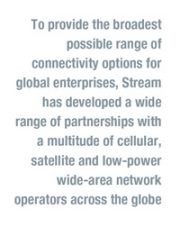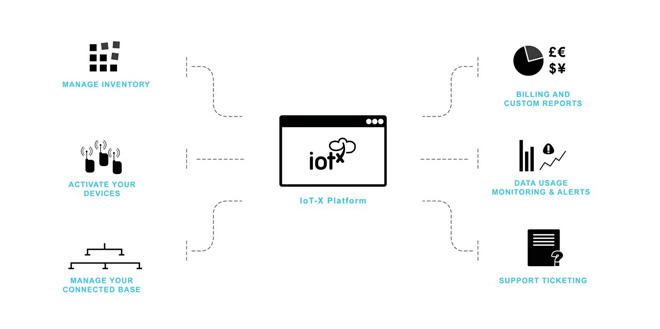As the Internet of Things (IoT) continues to mature organisations are looking for platforms that can provide them with the widest possible range of connectivity options and support services. Here, Jim Morrish, the chief research officer at Machina Research, interviews Nigel Chadwick, the chief executive of Stream Technologies to learn what companies want in the IoT and how they want to buy their services
Jim Morrish: Stream Technologies is a well-known name in the IoT, but can you summarise for me exactly what it is that you do?
Nigel Chadwick: In a nutshell, we enable companies to ship products that are ready to connect as soon as they are powered-up, and wherever they may be in the world.
Underpinning that proposition are a set of core products and services that can be divided into two parts. The first part centres around the worldwide wireless connectivity products and services that we provide to global enterprises. Typically, the connectivity services provided by Stream are delivered across cellular networks, however, we also provide satellite connectivity for customers who are transmitting business critical data from remote locations, and LoRaWAN connectivity for customers who need long-range, low-power connectivity for large-scale IoT deployments.

To provide the broadest possible range of connectivity options for global enterprises, Stream has developed a wide range of partnerships with a multitude of cellular, satellite and low-power widearea network operators across the globe. The integrated connectivity options provided by Stream allow international enterprises to benefit from lowcost, global IoT connectivity that reduces time to market and increases the usability of the enterprise’s connected product set.
The second part of the company is focused on the development of IoT-X – Stream’s award-winning connectivity management platform. IoT-X monitors, manages and monetises device endpoints and provides customers with subscriber management, billing, data routing and reporting capabilities from one centralised location. IoT-X is provided to Stream’s connectivity customers as either softwareas-a-service (SaaS) or as infrastructure-as-a-service (IaaS), depending on use case. IoT-X is also available as a platform-as-a-service (PaaS) for service providers, mobile network operators (MNOs), mobile virtual network operators (MVNOs) and enterprises that are managing their own connected device solutions.
 Through IoT-X PaaS, Stream can enable enterprises to operate as an MVNO of Stream, or any carrier Stream integrates on the enterprise’s behalf. The combination of embedded universal integrated circuit card (eUICC) connectivity and enhanced roaming management with data routing and cloud integrations positions IoT-X as the ideal enabler of IoT connectivity.
Through IoT-X PaaS, Stream can enable enterprises to operate as an MVNO of Stream, or any carrier Stream integrates on the enterprise’s behalf. The combination of embedded universal integrated circuit card (eUICC) connectivity and enhanced roaming management with data routing and cloud integrations positions IoT-X as the ideal enabler of IoT connectivity.
Through this combined offering, Stream’s objective is to enable global enterprises to realise their connected device strategy by providing high-quality connectivity services, innovative software solutions and unrivalled levels of technical support.
JM: That sounds good, but can you bring it to life with a use case example?
NC: With projections that the world will have 50 billion IoT enabled devices by 2020, an increasing number of device manufacturers are producing IoT enabled devices. In this situation, connectivity is a critical element in delivering a complete solution as without it, the entire application ceases to function.
Conventionally, the enterprise is faced with two options:
1. Procure connectivity from a third party.
2. Become an MVNO or service provider in the communications technology of their choice.

Through IoT-X PaaS, Stream aims to provide a third option, which addresses any concerns the enterprise may have concerning connectivity quality and which also allows the enterprise to maintain control of the customer user experience, the support process and pricing.
JM: How would that work from the perspective of the companies engaged in providing the solution?
NC: By providing IoT-X as a PaaS, Stream enables enterprises to deliver Stream’s connectivity services to their own customers. In this model, Stream functions as an enabler of cellular, satellite and lowpower wide-area network connectivity for the enterprise. Via Stream and our partner networks, the enterprise can seamlessly route the data gathered by their devices on to a common, cloud-based application.
The PaaS model enables the enterprise to operate as a telecoms provider for their customers, either by bundling the associated data costs in to a service fee, or by billing customers based on network usage. Stream provides the ability for all the enterprise’s traffic to be routed privately and securely to the end application, which ensures that the enterprise and end-customer avoid cost overruns and bill shock.

In addition, IoT-X includes granular device performance information. For example, the user can determine at a glance, how a device is performing down to the specific cell or gateway on any network integrated with IoT-X, as well as the hundreds of partner networks with which Stream has integrated. IoT-X can monitor millions of devices on hundreds of networks, which allows issues to be detected on a network and country level. If an issue is detected, remedial action can be taken quickly to minimise any potential impact. The granular level of detail provided by IoT-X differentiates the platform from alternatives, as this level of insight is not available in any other platform or connectivity service.
Stream has partnered with key providers in the field to deliver a comprehensive connectivity solution which ranges from eUICC provisioning, global connectivity, roaming QoS, and connectivity management services. Of course, it is possible for enterprises to go to operators directly to obtain network provision, however, Stream’s existing partnerships with multiple operators across the globe mean that enterprises have access to low-cost, global IoT connectivity, without the headache of integrating and interacting with multiple vendors and their various connectivity management platforms on an individual basis.
The combination of these factors positions IoT-X as an ideal solution for global enterprises, such as device manufacturers, who want to provide IoT connectivity to their own customer base.
JM: Presumably there’s some clever technical stuff going on under the hood, how does that all work?
NC: The IoT is nothing without data and that data usually relies on some form of connectivity. To ensure that Stream provides resilient and reliable connectivity services to customers, the company has developed a highly fault-tolerant, global network infrastructure. Stream’s network is connected using diverse carriers with N+1 redundancy on all links, equipment and sites. The network is regularly load tested to ensure that there is more than sufficient capacity to host the entire infrastructure from one site. The quality coverage and rapid connection speeds delivered by Stream’s connectivity services are assured by an array of private backhaul links, which provide fast and secure connectivity between the Stream network and partner networks.

Stream’s global, fault-tolerant IP network serves subscribers across the globe. It is divided in to discrete subnets, which allows enterprises to establish virtual private networks and provide secure, remote access to their corporate infrastructure from any location in the world.
For non-IP networks, such as low-power wide-area networks, Stream has developed a high availability message bus architecture. This allows a publishsubscribe model to be deployed, which enables data to be published directly to cloud servers running services such as IBM Watson, Microsoft Azure and Amazon’s AWS. Stream’s IP network even supports direct interconnection with both AWS and Azure.
 To deliver a truly future-proof solution to enterprises, Stream is continually evolving the services that we provide. For example, in addition to having a wide range of partnerships with a multitude of cellular, satellite and low-power wide-area network operators across the globe, Stream are also integrating the GSMA eUICC specification to allow remote profile swapping on deployed SIMs. Stream’s global roaming solution is being utilised as the bootstrap IMSI, which instantly provides access to over 200 countries worldwide, where roaming services can be used and, where required, new high-capacity profiles can be made available driven by enterprise demand.
To deliver a truly future-proof solution to enterprises, Stream is continually evolving the services that we provide. For example, in addition to having a wide range of partnerships with a multitude of cellular, satellite and low-power wide-area network operators across the globe, Stream are also integrating the GSMA eUICC specification to allow remote profile swapping on deployed SIMs. Stream’s global roaming solution is being utilised as the bootstrap IMSI, which instantly provides access to over 200 countries worldwide, where roaming services can be used and, where required, new high-capacity profiles can be made available driven by enterprise demand.
Stream’s global roaming SIM continues to mature. Supported by a combination of smart roaming schemes, quality of service (QoS) management and preferred roaming agreements, Stream’s global SIM provides enterprises with connectivity anywhere on the globe. With an increasing number of connectivity options becoming available, Stream’s global SIM is ideal for enterprises looking for the widest possible range of connectivity options.
JM: So in a way this is consistent with a next stage of the evolution of the IoT?
NC: Yes, as the IoT continues to gain traction and we can expect it to transform more and more of the physical objects that surround us. The emerging philosophy in the industry seems to be that, anything that can be connected will be connected. This can be seen in Samsung’s commitment that by 2020, all its products will be connected to the internet.
From this it can be concluded that the IoT is having a huge impact on the way in which manufacturers produce devices. There is an increasing drive amongst manufacturers to adopt a build once, deploy locally model for IoT-enabled products. This model enables manufacturers to construct products in their existing factories, wherever these might be in the world, and ship them to customers through their usual channels. From here, the customer simply buys the product, switches it on: connectivity is built-in.
It’s clear that wireless, global connectivity is a critical element in this model. To that end, the partnerships that Stream has developed with key providers in the field to deliver a comprehensive connectivity solution which ranges from eUICC provisioning, global connectivity, roaming QoS, and connectivity management services ensures that global enterprises working with Stream can be assured of receiving the connectivity services they need to expand their IoT footprint.
JM: Any final thoughts on the overall direction of the market, and your role in it?
NC: Yes, the market is really beginning to mature and gain momentum now. There is tremendous potential for the industry, with applications ranging from wearables to smart homes and smart cities to connected healthcare delivery. What the world looks like in 2020 really will be very different to what it looks like now. The pace of change in the IoT space really has moved up a gear in the last 12 months or so.
Stream is ideally positioned to capitalise on the opportunities that the growth in the IoT industry presents. With a unique blend of high-quality, wireless connectivity services and the flexibility of the IoT-X connectivity management platform, Stream’s objective is to continue to enable global enterprises to realise their connected device strategy and expand their IoT footprint.






